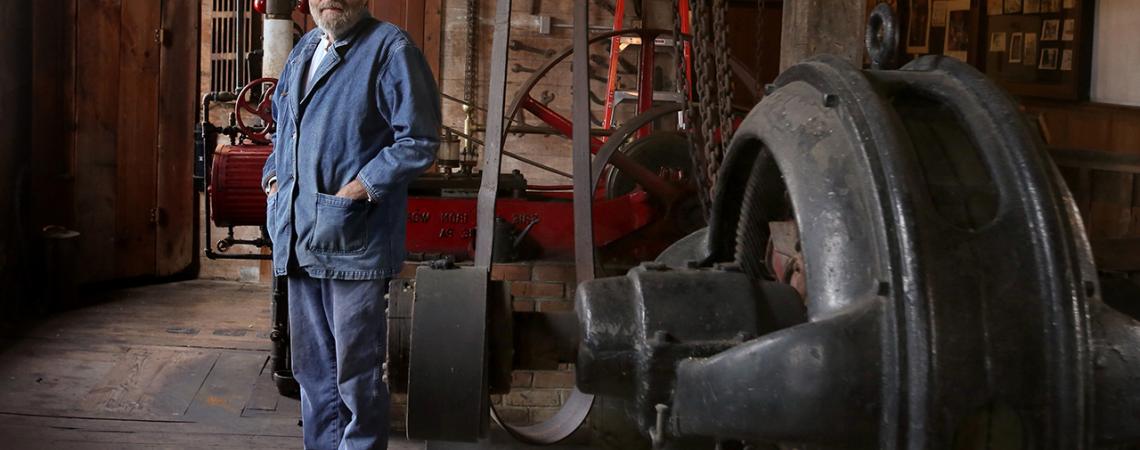Willie Ludwig inside the Ludwig Mill
Willie Ludwig usually can tell when the Isaac Ludwig Mill resonates with visitors. “People will walk into the mill, look around, take a big sniff, and smile,” he says. “Then they say it smells just like their grandfather’s old timber-frame barn smelled when they were kids.”
The wooden mill has stood beside the Maumee River ever since Isaac Ludwig, Willie’s great-great-great-grandfather, finished building it in 1849. “Inside the mill today, you can still see hand-hewn timbers from Isaac’s time,” Ludwig says. Willie’s great-uncle Cleo Ludwig donated the mill to the Metroparks of the Toledo Area in the 1970s, and it’s been converted into a living history museum at Providence Metropark near Grand Rapids.
“Great-Uncle Cleo told the park district people they could have the mill property for free if they painted ‘Isaac Ludwig Mill’ on the building, never charged admission, and filled it with working milling equipment to educate people,” Ludwig says.
Employed as a bench jeweler in Toledo, Ludwig has been a Providence Metropark volunteer for years; he helps with everything from mill maintenance to guiding tours for the schoolchildren who regularly visit. He also is a long-standing member of the Society for the Preservation of Old Mills, and has been both president and vice president of its Great Lakes chapter. According to Ludwig, mills played an important role in Ohio during the 1800s. By harnessing the state’s abundant streams, water-powered mills not only turned raw materials into marketable products, but they also became community centers where the nearby residents exchanged goods, news, and gossip. “During their heyday, Ohio probably had 2,500 mills,” Ludwig says. “Today, we’re down to about 30 that run.”
Isaac Ludwig Mill is among those historic Ohio mills that still operate and serve as gathering places by welcoming visitors. We’ve selected three more mills to feature on the next few pages, mills that offer tours or demonstrations — and by combining nostalgia with naturally scenic settings, they provide people with a step-back-in-time escape from the daily grind.
Down by the Old Mill Stream
Vaudeville singer and composer Tell Taylor wrote the classic ballad Down by the Old Mill Stream during a visit to his hometown of Findlay in 1908. He went fishing in the Blanchard River, where boyhood memories of the Misamore gristmill inspired his sentimental song’s music and lyrics. Popularized on the vaudeville circuit, Down by the Old Mill Stream remains a favorite for barbershop quartets. Today, a monument to Taylor’s fateful fishing trip stands in Findlay’s Riverside Park; the Hancock County Historical Society preserves a piece of millstone from Misamore Mill (and the Old Mill Stream Scenic Byway affords motorists a 52-mile heritage tour along the Blanchard River.
Bear’s Mill — Darke County
When the Society for the Preservation of Old Mills chose Bear’s Mill for its 2016 conference, the mill’s original equipment — including a Leffel turbine and French buhrstones — wowed the members. “When you go to the mill’s second floor, it’s still 1849, and we want to keep it that way,” says Terry Clark, the self-taught miller who uses locally grown grains to produce about 30,000 pounds of flour annually. Located east of Greenville, Bear’s Mill is a popular attraction, where folks buy the flours and baking mixes in the mill store, admire art in its gallery, and explore the beautiful mill property bordering Greenville Creek.
Clifton Mill — Clifton
The hundreds of vintage flour sacks hanging inside Clifton Mill attest to the Anthony Satariano family’s passion for collecting antiques. Of course, the greatest antique they ever acquired was the mill itself, which dates to 1869 and is one of the nation’s largest water-powered gristmills. It’s also among the most picturesque; the multi-story mill overlooks the Little Miami River from its woodsy perch on Clifton Gorge. Its dazzling Christmas display — the Legendary Lights of Clifton Mill — has made the mill famous, but visitors can also feast on plate-sized pancakes, sandwiches, and homemade biscuits in its restaurant.
Lanterman’s Mill — Youngstown
Built into the wall of a gorge in the 1840s, Lanterman’s Mill is the centerpiece of Mill Creek Park and boasts a massive stone foundation and splendid waterfall views. “The mill’s observation deck is a must-see,” notes Carol Vigorito, education director of Mill Creek MetroParks. “You get an up-close look at Lanterman’s Falls and can feel the power of the water.” Visitors also can follow the milling operation from start to finish at the mill, where park personnel use a 4-ton water wheel to grind the cornmeal and wheat flours sold at its on-site store. Open April through November; days and hours vary.









